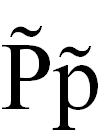| P with tilde | |
|---|---|
| P̃ p̃ | |
 | |
| Usage | |
| Writing system | Latin script |
| Type | Alphabet |
| Language of origin | Yanesha |
| Sound values | [k͡p] |
| In Unicode | U+0050, U+0070, U+0303 |
| History | |
| Development |
|
| Other | |
P̃ (majuscule: P̃, minuscule: p̃) is a Latin P with a diacritical tilde. It is or was used as a grapheme in some languages of Vanuatu, such as North Efate, South Efate and Namakura, to represent a sound [k͡p], like the ⟨c⟩ in "cat" and ⟨p⟩ in "pay", pronounced simultaneously. It is also used in the Yanesha language.
The letter was introduced by missionaries and has been in use for over a hundred years.
In Bislama, the lingua franca of Vanuatu, p with tilde is called snekpi "snake-P".
In Old English, it was used as a contraction of the penny, as in ⋅cxx⋅ p̃. ("120 pence").[1]
Computer encoding[edit]
Unicode encodes p with tilde with a combining diacritical mark (U+0303 ̃ COMBINING TILDE), rather than a precomposed character. As such, the tilde may not align properly with some fonts and systems. In standard HTML code: majuscule P̃, minuscule p̃. The Unicode HTML hex code is: minuscule p̃, majuscule P̃. The Unicode HTML decimal code is: minuscule p̃, majuscule P̃.
References[edit]
- ^ Thorpe, Benjamin (1840), "The Laws of King Edgar", Ancient Laws and Institutes of England; Comprising Laws enacted under the Anglo-Saxon Kings from Æthelbirht to Cnut, With an English Translation of the Saxon; The Laws called Edward the Confessor's; The Laws of William the Conqueror, and those ascribed to Henry the First: Also, Monumenta Ecclesiastica Anglicana, From the Seventh to the Tenth Century; And the Ancient Latin Version of the Anglo-Saxon Laws. With a Compendious Glossary, &c., London: Commissioners of the Public Records of the Kingdom, p. 113. (in Old English) & (in Latin) & (in English)
Well, that’s interesting to know that Psilotum nudum are known as whisk ferns. Psilotum nudum is the commoner species of the two. While the P. flaccidum is a rare species and is found in the tropical islands. Both the species are usually epiphytic in habit and grow upon tree ferns. These species may also be terrestrial and grow in humus or in the crevices of the rocks.
View the detailed Guide of Psilotum nudum: Detailed Study Of Psilotum Nudum (Whisk Fern), Classification, Anatomy, Reproduction